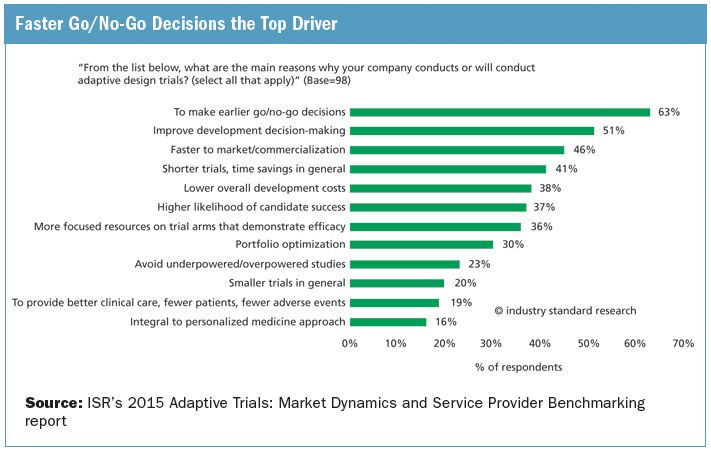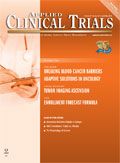Adaptive Trial Designs Gaining Momentum
Applied Clinical Trials
Faster go/no-go decisions is the primary driver of adaptive-design adoption by sponsors.
In ISR's 2015 Adaptive Trials: Market Dynamics and Service Provider Benchmarking report, a key takeaway reached is that the primary driver of adoption of adaptive designs is the ability to reach critical decision points earlier. This does not necessarily mean that trial timelines are shorter or costs are lower, but instead that the probable outcomes of these trials are determined earlier so resources can be more effectively allocated to more promising or profitable drugs or devices. ISR found this as a chief motivator for the continued growth of adaptive trial designs. While only 49% of respondents report that they are currently conducting a trial with an adaptive design, 82% anticipate they will be over the next 12 months.

Faster Go/No-Go Decisions the Top Driver
When ISR asked respondents what their main reasons were for conducting trials with adaptive designs, 63% said to make earlier go/no-go decisions.
The primary hesitation associated with using adaptive trial designs relates to the regulatory environment surrounding adaptive trials. Upwards of 60% of ISR's survey respondents perceived adaptive trials as at least "somewhat risky."
- Industry Standard Research (ISR)

Including Women of Childbearing Age in Clinical Research
March 26th 2024In recognition of International Women's Month, we're featuring this recent talk between Associate Editor Miranda Schmalfuhs and Marie Teil, Global Head of UCB’s Women of Childbearing Age Program. They speak about the specific challenges women with chronic illnesses face when accessing appropriate treatment and participating in clinical trials, UCB's Women of Childbearing Age Program and it’s most successful strategies, and much more.
Improving Engagement While Maintaining Data Integrity & Validity
March 19th 2024In recognition of Women's Health Month, we're featuring this recent talk between Associate Editor Miranda Schmalfuhs and uMotif's Chief Product Officer, Julia Lakeland, discuss new technologies improving patient engagement and reducing the emotional and logistical burdens of participation, ethical considerations that should be addressed when implementing those technologies, while ensuring patient privacy, and much more.
Using Patient Reported Outcomes in Dermatology Trials
April 25th 2024In part 3 of this video interview with ACT editor Andy Studna, Melissa Mooney, director, eCOA sales engineering, IQVIA sheds light on the unique challenges of dermatology trials and how clinical outcome assessments can be implemented in them.